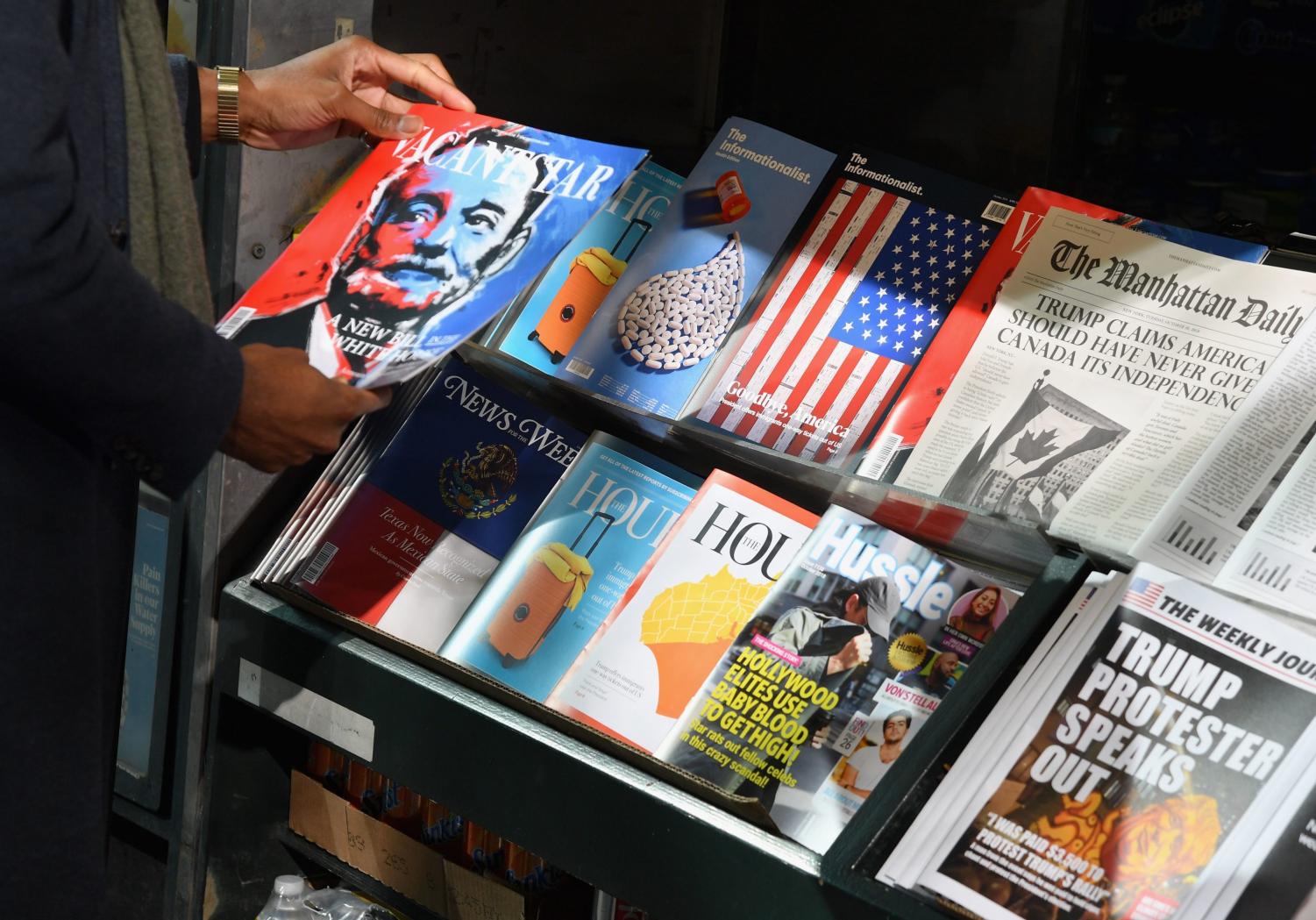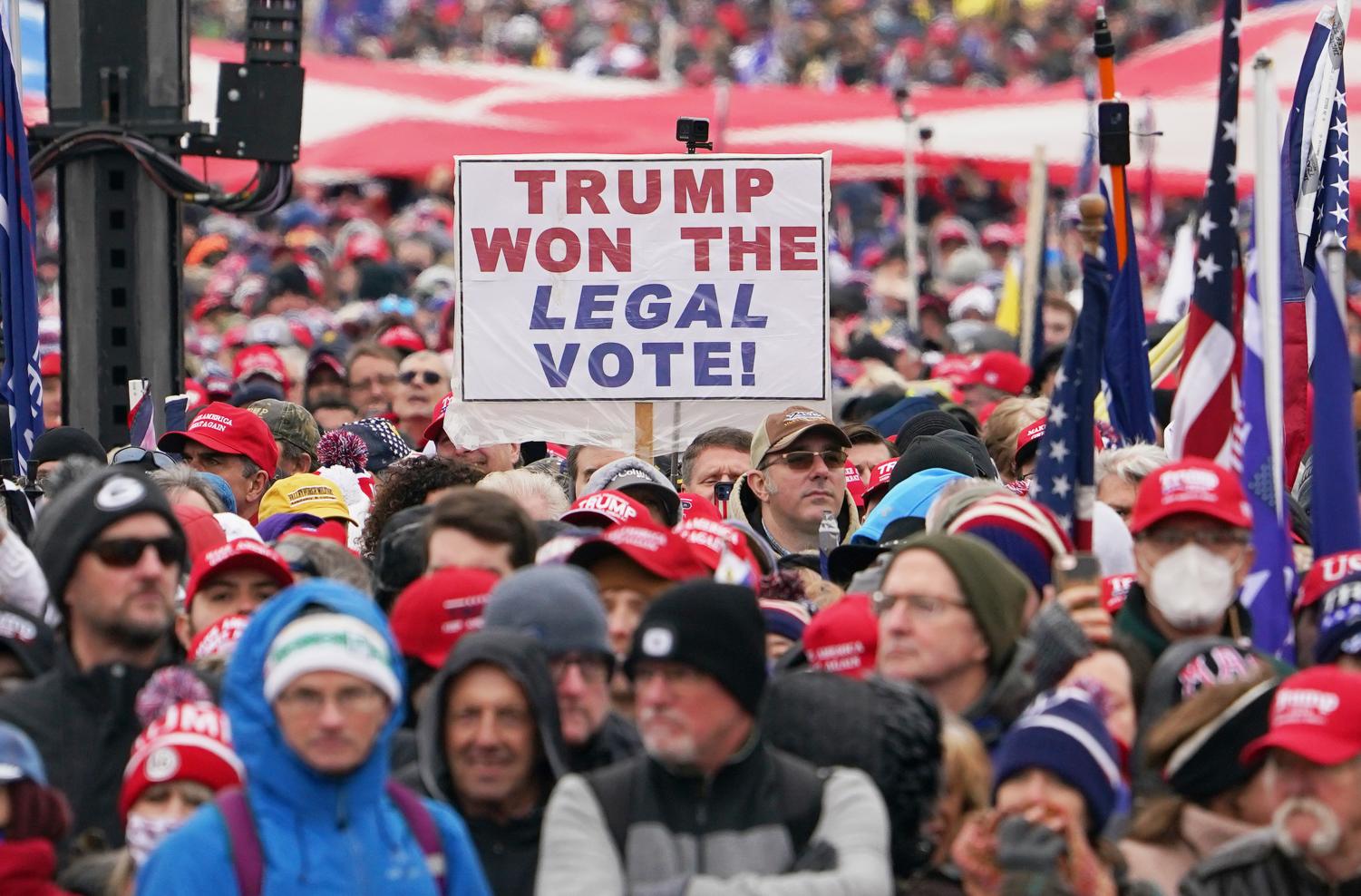
Sam Podnar is a senior at NASH. When she's not writing, she enjoys baking, reading, and talking too much about local politics.


Political falsehoods are nothing new, but the weaponization of them has pushed America to the breaking point.
February 17, 2021

Post-truth is defined as “relating to or existing in an environment in which facts are viewed as irrelevant, or less important than personal beliefs and opinions, and emotional appeals are used to influence public opinion.” The prefix “post” means not a time after truth, but rather an age in which the truth has become irrelevant. Oxford Dictionarie named it word of the year in 2016, when its usage increased 2,000% over 2015, and since then its relevance has only grown. The 2020 presidential election demonstrated how time and time again the truth was discarded in favor of misinformation and wild conspiracy theories surrounding, among other topics, voter fraud, Antifa, and of course, QAnon.
QAnon is a conspiracy theory centered around the belief that an all-powerful cabal of Satan worshipping Democrats and celebrities are running a pedophile ring and that Donald Trump is going to defeat them. The theory began when an anonymous user—who claims to be a high-ranking government official and is referred to as “Q” by believers—began posting on 4chan in 2017. Though it emerged and spread largely on the internet, it has had plenty of real world consequences, most notably the events on January 6th. Plenty of QAnon adherents could be found in the mob that stormed the Capitol building, including the man with red-white-and-blue face paint and horns who refers to himself as the “Q Shaman.” The rioters’ actions were motivated by the “Big Lie,” the belief that the election was fraudulent and that it could be corrected with violence. This devotion to a blatant lie is unmistakably post-truth, just like the rest of QAnon’s web of conspiracy.
It may be tempting to chalk up the rioters and QAnon adherents to the likes of a small cult whose believers are dangerous yet few in number. However, many people have bought into the conspiracy theory—56% of Republicans partially or fully believe in QAnon, according to a poll conducted last September, up ten percentage points from one year prior. During the 2020 election cycle, 97 Congressional candidates openly vouched their belief in QAnon, two of which were elected and currently serve in the House of Representatives. One of them is Marjorie Taylor Greene, who was recently stripped of her duties on two Congressional committees after she espoused her beliefs that the Parkland shooting was staged and “Jewish space lasers” caused the 2017 California wildfires.
After going into a deep-dive on QAnon and people like Greene, it’s easy to feel like the world has gone crazy. This growing and more vocal belief in cartoonishly outlandish conspiracy theories is indicative of how our politics, the way we form our opinions, and the spread of information are becoming more and more post-truth. For many Americans, former President Donald Trump is the culprit who started this trend. Making over 30,000 false or misleading claims during his presidency, Trump once said, “What you’re seeing and what you’re reading is not what’s happening,” in reference to the “fake news” broadcast about his trade tariffs in 2018—a quote that, like many QAnon details, reads like satire.
But post-truth itself can’t be traced back to just one politician or conspiracy theory, and it certainly didn’t begin just within the last four years. Author Yuval Noah Harari writes about how humanity has always relied on collectively imagined beliefs, such as sports or money, to allow millions of people to cooperate and operate according to the same rules. These shared fictions have been largely beneficial and are important in setting humanity apart from other animals. However, he agrees that the phenomena of recent years is abnormal. “Though we have always relied on made up institutions and ideologies to unite us and drive forward society,” he writes, “now more than ever before we are seeing the weaponization of lies.” The behavior observed in Trump and other post-truth leaders is uniquely dangerous because they not only ignore the truth but go to war with it.
Sverre Spoelstra continues this thought in his analysis of post-truth leaders. Echoing Harari’s sentiments, he writes about how politicians speaking in abstracts or fictions is nothing new. All throughout history, successful leaders have not spoken just in objective truths because that will not garner them support—they need to inspire people with visions of the future. Instead of focusing on the facts, they divert attention to their own reality, using illustrative language that cannot be fact checked because it is not true or false. The truth is pushed aside in order to gain supporters and paint the leader as someone made more extraordinary by the vision they create. But Trump takes this a step further. Spoelstra writes that “post-truth leaders like Trump are in a constant battle with factual reality.” Instead of simply avoiding the truth and distracting his supporters with grandiose promises, Trump combats facts head-on, doggedly arguing with things that can be easily proven true, like the results of the 2020 presidential election.
The Capitol riot, which left five dead and countless more injured or traumatized, happened as a direct result of Trump’s manipulation of reality. The basis of the rioters’ anger was a lie about the results of the election, one that was perpetuated by other GOP politicians who spent January 6th and the days after denouncing the madman they enabled and hiding from the monsters they helped him create. Post-truth politics and their consequences are upheld not just by those who tell the original lie, but also by the people who echo it. If we want to protect our sacred institutions of democracy and preserve reality, we must use science, logic, and facts against the crowds of very outspoken people who use post-truth rhetoric to try to convince us that what we’re seeing isn’t real.

How do we fight the storm of lies that culminated in the Capitol riot? First, we must identify the people who believe the lies and even take action because of them. Those most likely to buy into Trump’s rhetoric are non-college educated whites, a group that makes up much of his base. With 41% of eligible voters without a college education, this bloc is not insignificant, and their lack of tertiary education plays a big role in their political beliefs. A 2017 study found that lower levels of education correspond to belief in conspiracy theories—people with less education are more likely to feel powerless and seek out simple solutions for complex problems, two holes that conspiracy theories like QAnon fill.
The research paper explained that education strengthens problem-solving skills and analytic thinking, while conspiracy theories are formed from intuitive thinking, which relies on instincts rather than careful reasoning. Because they feel out of control and marginalized, people with lower levels of education seek dots to connect in order to make sense of reality, even if those connections are ridiculous or false. By rallying his supporters around just a few messages that he espouses constantly, Trump offers the illusion of simplicity in a world that can otherwise feel over-complicated. It’s no shock that he speaks to the public at a fourth-grade level—his messages are blunt and straightforward, meant to excite his supporters and offer them easy solutions in a complicated world.
This is not to place the entirety of blame on those who have received a bad education for their misguided belief in conspiracy theories and charlatans like Trump—rather, it is to highlight the systems that have failed these people and put them in the position to be manipulated. Children in low-income areas receive an inferior education, an inferior education leaves them more likely to fall into poverty, and the cycle continues, leaving large groups of people susceptible to lies because they haven’t been given the tools to combat them. Politicians like Trump tell them that their problems are because of people of color, immigrants, the media, foreign countries, and secret groups of powerful “elites,” when in reality it’s those same politicians that don’t improve their schools or do anything to lift them out of poverty.
This exploitation and deception by the same leaders who claim to be champions for the people is appalling. Professor John Keane draws connections between the behavior of politicians and that of gaslighters, writing, “Their point is to disorient and destabilize people. They want to harness people’s self-doubts, ruin their capacity for seeing the world ironically, destroy their capacity for making judgements, in order to drive them durably into submission.”
As we grapple with the Capitol riot from just a month ago, we have to examine not just the individual actors who stormed the Senate chamber, but also the politicians who stoked the fires of hatred and cried election fraud at every turn. We must hold accountable the government officials whose words drove people to plant bombs and smash windows trying to reach the Congressmen they were led to believe had to be assassinated.
This hysteria is not normal. Investigating the intricacies of QAnon can be intriguing and even hilarious, but when you realize that potentially millions of people wholeheartedly believe in Democrat-led pedophile rings run out of a pizzeria basement, the state of our country begins to feel like a nightmare. Post-truth politics is frightening because it doesn’t conform to any rules, it doesn’t acknowledge its own absurdity, and it has devastating, tangible impacts on the world. We saw the dangers of the weaponization of lies on January 6th, scattered across the 2020 campaign trail, and throughout the COVID pandemic. We see it as the climate crisis worsens because world leaders delay action and say things like, “It’ll start getting cooler,” as hundreds of thousands of Americans die from a disease because many of our politicians refuse to believe in science, and as anti-Semitic and Islamophobic hate crimes are committed because people have been driven to violence from the conspiracy theories they consume. It’s maddening to think about how we got here, about how common sense and facts have been thrown out the window in favor of things that sound like they belong in a badly-rated spy movie.
How do we fight this and keep the wildfire of false information from doing any more damage? One culprit to tackle is large social media sites who do little to combat fake information and whose algorithms drive people to extremes. But we also have to arm people with education, give them the intention and ability to seek the truth so that they’re not just being tossed around by whoever is the most charismatic. We can use education not only as a tool with which people can arm themselves to discern disinformation from reality, but also as an avenue through which we can prepare the next generation of leaders to have integrity and commit themselves to the truth.
In 50 years, high school students might read about this era and chuckle at its comical absurdity. But while we are still living through a time when people attempt to decipher the secret meaning of Trump’s tweets containing the letter “q” and how the colors of his tie relate to maritime flags, we must do all that we can to ensure that this dangerous period of post-truth is a blip in history, rather than a new normal.

Sam Podnar is a senior at NASH. When she's not writing, she enjoys baking, reading, and talking too much about local politics.